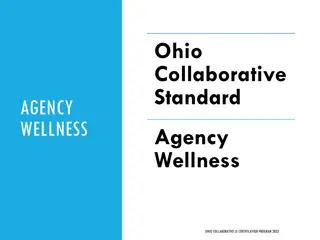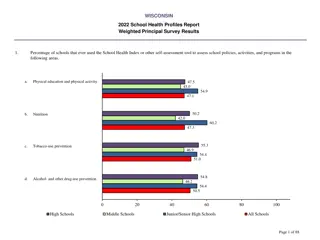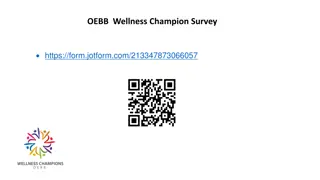Strategies for Increasing Participation Rates in Wellness Programs
Explore effective strategies and recommendations for increasing employee participation rates in wellness programs, based on research findings and expert insights. Understand the key factors influencing adoption and participation in wellness initiatives to promote a healthy workplace culture.
Uploaded on Mar 02, 2025 | 1 Views
Download Presentation

Please find below an Image/Link to download the presentation.
The content on the website is provided AS IS for your information and personal use only. It may not be sold, licensed, or shared on other websites without obtaining consent from the author.If you encounter any issues during the download, it is possible that the publisher has removed the file from their server.
You are allowed to download the files provided on this website for personal or commercial use, subject to the condition that they are used lawfully. All files are the property of their respective owners.
The content on the website is provided AS IS for your information and personal use only. It may not be sold, licensed, or shared on other websites without obtaining consent from the author.
E N D
Presentation Transcript
Strategies for Increasing Participation Rates in Wellness Programs Cristina G. Banks, PhD Isabelle J. C. Thibau, MPH Interdisciplinary Center for Healthy Workplaces University of California, Berkeley
Presentation Overview The problem with participation rates Framework for increasing motivation to participate What works: Focus Group Study Learnings from the Focus Group Study Recommendations for increasing adoption of wellness programs in small to medium-sized organizations Recommendations for increasing participation rates
Definition of Wellness Program Transamerica Center for Health Studies (sponsor) Harris Poll 2017 Definition: 1. Health education by providing information promoting health in general (pamphlets, informational meetings, online tips and messages) 2. Health advice from a qualified vendor (coach, health professional) for promoting healthy behavior (sleep, physical activity, nutrition, stress management) 3. Individual mental or physical health tracking through a wearable device or online program (Fitbit, Jawbone, MoodKit) 4. Targeted behavior change programs for high risk employees (smoking cessation, weight/disease/alcohol management, medication compliance) 5. Healthy food/drink offerings in-house (cafeteria, vending, free) 6. Clinical screenings and biometric assessments (HRA) 7. Social engagement (social clubs, interest groups, sports teams) 8. Mindfulness, meditation, yoga, relaxation training 9. Links to related employee services for support with personal issues (referral to employee assistance programs--EAP) 10. Ergonomic furniture/equipment 11. Subsidized gym memberships 12. Fitness gym facilities or outdoors exercise areas
The Problem Adoption Rates of Wellness Programs All organizations: 55.2% Small organizations (1-49): 24.7% Medium organizations (50-499): 76.9% Large organizations (500+): 82.6% Employee Report vs. Employer Report Employees report lower rates Small organizations: 17.1% Medium organizations: 41.5% Large organizations: 52.9% Highest Reported Participation Rates in Wellness Programs Participation levels were <10%, 11-20%, 21-40%, 41-50%, >50% Small organizations: >50% Medium organizations: 21-40% Large organizations: 41-50% Low participation = Poor test of wellness program effectiveness
Re-thinking Wellness Program Adoption and Participation Adoption: What makes wellness programs easy to adopt? Organizational requirements to successfully launch WP Features of the organization Fit between the Features and the Organizational Requirements Participation: What makes a wellness program attractive to an employee? Employee s perceived need Employee s perception that the wellness program addresses that need Motivation to participate in WP > motivation to do something else or nothing at all Establish the WIFM
What works in small and medium-sized organizations? What wellness programs are offered? How were they established? Who participates in these programs? How successful are these programs? What are the unique factors in small and medium-sized organizations that make success more likely? What are the unique factors that make success less likely?
Focus Group Study 19 Organizations representing multiple industries and geographies 1 to 3 focus groups conducted in each organization, 2 to 8 participants in each focus group (total N = 162) Leadership/Managers: 65 HR: 30 Employees: 67 Topics: Wellness programs implemented Facilitators Barriers
Focus Group Findings Wellness Programs offered in small organizations Healthy food/drink offerings in-house (cafeteria, vending, free) (N=2) Social engagement (social clubs, interest groups, sports teams) (N=5) Links to related employee services for support with personal issues (referral to employee assistance programs--EAP) (N=2) Ergonomic furniture/equipment (N=4) Fitness gym facilities or outdoors exercise areas (N=2) Other (N=6)
Focus Group Findings Wellness Programs offered in medium-sized organizations Health education by providing information promoting health in general (N=4) Health advice from a qualified vendor for promoting healthy behavior (N=5) Individual mental or physical health tracking through a wearable device or online program (N=2) Targeted behavior change programs for high risk employees (N=2) Healthy food/drink offerings in-house (N=8) Clinical screenings and biometric assessments (HRA) (N=4) Social engagement (N=10) Mindfulness, meditation, yoga, relaxation training (N=8) Links to related employee services for support with personal issues (N=4) Ergonomic furniture/equipment (N=9) Subsidized gym memberships (N=2) Fitness gym facilities or outdoors exercise areas (N=7) Other (N=9)
Facilitators of Wellness Program Success Wellness initiatives align with organizational constraints Convenience Reasonable work hours Leadership understands the link between health and work outcomes Leadership understands employee needs and preferences Leadership support Culture of health at work WP appeals to personal preferences Built environment designed for health and wellness Acknowledging low-cost options Strong communication system
Barriers to Wellness Program Success Inconvenience Nature of Work Lack of clarity regarding the link between wellness programs and business outcomes Concerns about funding Leadership issues: attitudes towards wellness Lack of experience with wellness Perceived lack of need Inaccurate perceptions of wellness program failure Confusion about insurance Lack of clear ownership Lack of active and consistent leadership support Lack of culture of health Low morale Lack of financial resources Long work hours Employees occupy multiple roles Failure to take full advantage of insurance Bureaucratic and logistical issues Organization not self-insured Poor communication Concerns about liability
Fit Between Organization Features and Wellness Program Requirements Key factor: Leadership involvement in wellness programs Levels of involvement adoption of wellness program type Hierarchical Model of Organization Involvement
Fit Between Employee Needs and Wellness Program Offerings Key Factor: WIFM Types Knowledge Services Behavior change Designed-in health nudges Needs match program content
How to Create the WIFM: Methods of Influence Rewards Coercion Framing Changing the physical environment Making exchanges
What works? Statements About Organizational Fit One exemplary organization administered employee feedback surveys because they wanted to refrain from applying a blanket approach to wellness, and were instead hoping to personalize wellness based on the nuances of their specific employee population. Our employees care about wellness and living an active lifestyle. It is integral to our company motto. Wellness is one of our strongest cultural competencies as a company. One organization decided that, due to financial limitations, their wellness program would be a wellness awareness program, one that was primarily educational in nature. As such, they focused on distributing health resources to employees. I think that there s a balance since we are a small company with providing things but also resources and we are seeing more engagement as we add more -- I think it s really important in a small company where the pay may be lower but the opportunities are grand
What works? Statements About Need Satisfaction I do get stressed sometimes and being able to be aware so that I can interact with people around me better is nice Positive as opposed to negative messaging (e.g., Participate to stay fit! as opposed to Participate to lose weight! ) Take what you need, and it s reassuring to know that whatever you need, the company stands behind. Do what you need, and we trust you not to take advantage of that a truly spectacular platform of comfort. There are a lot of employees who are engaged I think they do it because they like it. Provides opportunity that takes us away from day to day and interact with each others The reason I am still with this company is because I get an incredible deal with parental leaves and flexible scheduling.
Recommendations for Increasing Adoption Identify the type of wellness program that matches the organization s desired level of involvement. Share knowledge of the relationship between employee wellness and important organizational outcomes. Shift the conversation from ROI to increased employee capability through wellness. Augment wellness opportunities by making external resources accessible to all employees.
Recommendations for Increasing Participation Learn what employees need. Identify wellness programs that meet those needs. Provide organizational support to employees to help them participate in the wellness programs adopted. Track participation and solicit employee feedback on the fit between their needs and program effectiveness. Acknowledge employees achievement of wellness goals. Continuously evolve wellness programs as needs change.
Thank You Healthyworkplaces.Berkeley.edu























